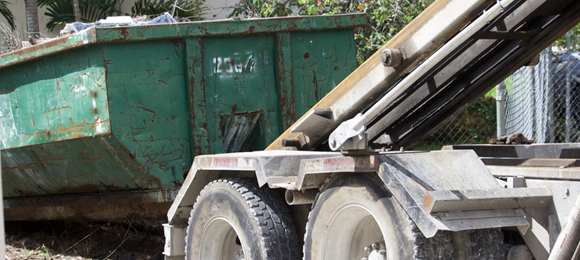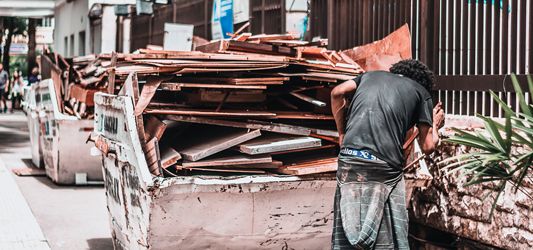
Updated March 15, 2024
Communities thrive when individuals come together to make a positive impact on the environment.
Planning a community cleanup event is not only a great way to beautify the surroundings but also fosters a sense of unity and shared responsibility within your community.
Whether you're a community leader, activist, or concerned citizen, organizing a successful community cleanup event requires careful planning, collaboration, and dedication. By following this guide, you can create an event that not only addresses environmental concerns but also strengthens the bonds within your community.
In this guide, we discuss:
- What Is a Community Cleanup Event?
- Benefits of a Community Cleanup Event
- How to Organize a Community Cleanup
Find dumpster rentals near you
What Is a Community Cleanup Event?
A community cleanup event is a collective effort where members of a community come together to clean and improve a neighborhood, park, beach, or street. There are some community cleanups that are much larger, like the Great American Cleanup.
The primary goal of these events is to enhance the local environment, promote civic pride, and foster a sense of community responsibility. Community cleanup events typically involve volunteers, local residents, businesses, and sometimes government or non-profit organizations.
During a cleanup event, participants may engage in various activities to make the area more clean and beautiful, such as:
- Picking up litter
- Removing graffiti
- Planting trees or flowers
- Painting public spaces
These events are often organized periodically, most often on a yearly basis, or in response to specific needs, like after a public event, during environmental awareness campaigns, or as part of ongoing efforts to maintain a clean and attractive community. The success of these events relies on the active participation and commitment of community members working together to achieve their goal.
Read more: Dumpster Rental for Events and Festivals: Managing Waste Responsibly
Benefits of a Community Cleanup
Community cleanup events offer a variety of benefits. Here are some of the main advantages:
-
Improved Aesthetics: Cleanup events help enhance the visual appeal of a community by removing litter, graffiti, and other forms of environmental pollution.
-
Environmental Preservation: By picking up trash and properly disposing of waste, community cleanup events contribute to the protection of natural habitats, wildlife, and ecosystems.
-
Health and Safety: Cleaner environments reduce health risks associated with pollution and waste. Cleanup events can help create safer spaces for community members, especially children and pets.
-
Community Pride: Participating in a cleanup fosters a sense of pride and ownership among community members. It encourages people to take responsibility for their surroundings and instills a sense of civic duty.
-
Social Bonding: Cleanup events bring people together, promoting social interactions and strengthening community ties. Working side by side towards a common goal fosters a sense of unity.
-
Educational Opportunities: These events provide educational opportunities to raise awareness about environmental issues, proper waste management, and the importance of sustainable practices.
-
Positive Public Image: Communities that regularly engage in cleanup activities often gain a positive public image. This can attract businesses, residents, and visitors, positively impacting the overall perception of the area.
-
Community Engagement: Cleanup events serve as a platform for community engagement and involvement. They encourage residents to actively participate in local initiatives and connect with one another.
-
Environmental Education: Cleanup events often include educational components, teaching participants about the impact of pollution on the environment and the importance of reducing waste.
-
Inspiration for Ongoing Initiatives: Successful cleanup events can inspire ongoing community initiatives focused on environmental sustainability, such as recycling programs, tree planting campaigns, or neighborhood beautification projects.
-
Support for Local Businesses: A cleaner and more attractive community can positively influence local businesses by creating a more welcoming environment for customers.
Find dumpster rentals near me
How to Organize a Community Cleanup

Step 1: Choose a Location and Define Objectives
Before diving into the logistics of planning a cleanup event, it's crucial to establish clear objectives. Ask yourself and your team:
- What specific areas need cleaning? - Because not every street, beach, or neighborhood is desperate for a thorough cleaning, it's important to first take some time to decide on the best area to focus your cleanup on.
- What environmental issues are you addressing? - If the area you chose for your cleanup has specific issues that need to be addressed (e.g., litter, pollution, graffiti), those issues should be addressed and the main focus of your cleanup.
- What is the overall goal of the cleanup? - Every community event should have a goal in mind. For example, is your community cleanup a general beautification project? Are you trying to address specific concerns? Is it an effort to increase overall environmental awareness? Your goals will affect how you go about organizing the event.
- How will you measure the success of the event? - Measuring the success of a community cleanup event is essential for accountability, event improvement, and proving the positive impact on the community and the environment. It provides valuable information that can guide future initiatives and ensure that resources are used effectively to address community needs.
Establishing clear objectives will guide your planning process and help communicate the purpose of the event to participants and the community at large.
Step 2: Build a Team
A successful community cleanup event requires a dedicated and enthusiastic team, and the more participants you recruit, the more litter (and data) can be collected. We recommend reaching out to volunteers from the community, local schools, businesses, and organizations. Then, establish clear roles and responsibilities, including event coordination, volunteer management, marketing, and logistics to help ensure your event runs smoothly and everyone knows what their duties are.
You don't need 100 people to volunteer in order to make your community cleanup a success. Instead, focus on your goals and invest your efforts into doing what you can with the team you have. Remember: A small cleanup event is better than no cleanup event!
Step 3: Choose a Date and Time
Consider factors like weather, local events, and community schedules when selecting a date and time for your cleanup. Weekends are often popular choices, as they allow more people to participate, but do your best to be mindful of potential conflicts to maximize attendance.
Step 4: Secure Sponsors
It can be helpful to engage local businesses, government agencies, and environmental organizations as sponsors or partners of the event. They can provide financial support, in-kind donations, or even volunteer assistance. Establishing these partnerships can enhance the impact of your cleanup event and increase community involvement.
Step 5: Assemble Cleanup Equipment
Make a list of the supplies you'll need for the cleanup, including trash bags, gloves, trash pickers, temporary dumpster rentals, recycling bins, and cleaning tools, like those you'd need to clean graffiti. Ensure that you have enough resources to accommodate the expected number of participants. We also recommend reaching out to local businesses to see if they have any interest in donating or providing discounts on supplies for the event.
Learn more: How Many Dumpsters Do I Need?
Step 6: Have a Disposal Plan
Coordinate with local waste management services to ensure volunteers and residents have easy access to proper disposal of collected trash and recyclables. Dumpster rentals are often a go-to method for waste management during a cleanup event. A dumpster will allow you to coordinate the efficient transportation of waste to designated disposal sites and make it easy for volunteers to toss trash bags and other items removed during the cleanup. Recycling as much as possible will contribute to the overall environmental impact of the cleanup, and many dumpster rental companies offer recycling services, so be sure to discuss this with the dumpster rental companies you speak to.
At the end of the cleanup event, or as it's going on, keep the area around the dumpster clear of debris, sweeping it regularly to ensure no waste is left behind and no sharp objects are posing risks. This is a small step volunteers can take to make a big difference in the overall cleanliness of the area.
Step 7: Obtain Necessary Permits and Permissions
Check with local authorities to ensure you have the required permits for your cleanup event. In many cases, renting a dumpster and placing it in a public right of way will require a permit.
Obtain permission from property owners if the cleanup involves private land. Understanding and adhering to local regulations will help your event run smoothly and avoid any legal complications.
Step 8: Promote Your Event
Create a comprehensive marketing plan to promote your community cleanup event and enlist additional help. Utilize social media, local newspapers, community bulletin boards, and word of mouth to spread the word. Clearly communicate the event details, objectives, and the positive impact participants will have on the community.
Next Door and neighborhood Facebook groups are a great resource for letting people within your community know about the event.
Step 9: Provide Clear Instructions to Participants
Prioritize safety by providing participants with clear instructions and guidelines. Brief them on the specific areas to clean, waste disposal procedures, and any safety precautions. Encourage participants to wear the appropriate clothing and safety gear when handling trash.
Step 10: Perform Cleanup
Once you have your volunteers briefed on proper procedure, it's time to get to work! Make the process smooth for everyone by posting the rules and etiquette associated with using a dumpster so everyone understands how the dumpster and junk disposal will work. Ensuring that everyone uses the dumpster correctly and efficiently can make a significant difference. Post clear signage at your site to ensure that waste is separated and placed in the appropriate bin.
Keep reading: Green Solutions: The Environmental Benefits of Responsible Dumpster Rental
Step 11: Track & Report Data
Throughout your event, make note of any important data, like how many people participated, before and after photos of the cleanup area, how many yards of waste (and what types) were removed, graffiti that was cleaned, and any other pertinent data. You should be proud of your accomplishments and you should share them with your community. Not to mention, it provides valuable insight into what can be done to improve upon the event in the future.


